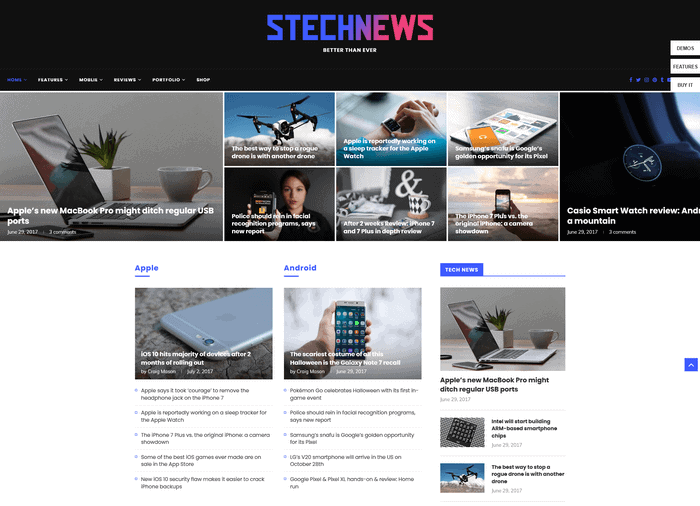Why the Best tech blog is Your Go-To Resource for Professional Reviews and Insights
Why the Best tech blog is Your Go-To Resource for Professional Reviews and Insights
Blog Article
Understanding the Rise of Edge Computing in Today's Digital World
In the quickly progressing landscape of modern technology, side computer becomes an essential force, reshaping how information is refined and made use of. This paradigm shift is driven by the proliferation of IoT tools and a rising demand for instant data handling. By transitioning information administration closer to the source, side computer addresses crucial latency problems while optimizing data transfer use and boosting safety actions. As markets pivot towards smarter, much more efficient systems, understanding the subtleties and ramifications of this technological innovation comes to be imperative. What does this mean for future advancements and the digital community overall?
What Is Edge Computer
Edge computing, although a relatively current improvement in the realm of innovation, fundamentally transforms just how data is refined and handled by bringing computation and information storage space closer to the place where it is needed. Unlike typical cloud computer designs, which often depend on centralized information facilities that can be geographically remote, side computing decentralizes data handling. This closeness lowers latency, improves real-time information handling, and improves the overall individual experience by making sure much faster action times.
At its core, edge computer involves a network of local devices and facilities, such as gateways, routers, and sensing units, efficient in refining data at or near the resource. This localized handling capacity is specifically crucial for applications requiring instant data analysis, such as self-governing automobiles, commercial automation, and wise cities. In addition, by offloading data processing tasks from main web servers, side computer minimizes data transfer needs and boosts information privacy and safety, as delicate info can remain on-site instead than passing through considerable networks.

Trick Motorists of Adoption
A number of factors are thrusting the adoption of side computer in today's digital landscape. Among the key chauffeurs is the rapid increase in connected tools, frequently described as the Net of Things (IoT) This surge develops vast amounts of information that require to be processed swiftly and successfully. Edge calculating addresses this requirement by enabling information handling closer to the information resource, decreasing latency and boosting real-time decision-making capabilities.
Another considerable motorist is the need for enhanced transmission capacity performance. Central cloud systems can come to be overloaded with the large quantity of information produced by IoT gadgets, causing traffic jams (Best tech blog). By processing data at the edge, organizations can minimize network congestion and improve overall system performance
Furthermore, protection and privacy concerns are pressing companies towards side computing. By processing delicate information in your area, business can alleviate dangers connected with data transmission and exposure to potential cyber threats.
The rise of applications needing real-time processing, such as self-governing automobiles and boosted truth, also necessitates the quick reaction times that border computing offers. Collectively, these drivers are making side calculating an essential component of modern-day IT facilities, paving the means for its extensive adoption throughout different industries.
Advantages Over Cloud Computer
Exactly how does side computer identify itself from conventional cloud computing? Largely, edge computing brings data processing closer to the resource of information generation, usually on local gadgets or neighboring web servers, instead than depending on central information.
In addition, edge computing enhances data transfer effectiveness (Best tech blog). By refining information in your area, only the required data is transferred to the cloud for additional evaluation or storage space, reducing the volume of data that traverses the network. This not only reduces network congestion but also lowers data transmission costs
Side site web computer likewise provides enhanced information personal privacy and safety. Delicate information can be refined locally without being sent to the cloud, decreasing the direct exposure to potential cyber risks. This is especially beneficial for sectors taking care of confidential details, such as health care and monetary services.
Moreover, edge computing makes certain better durability and reliability. Local handling enables for proceeded procedure even when connection to the cloud is jeopardized, maintaining important functions and solutions in spite of potential network interruptions. These advantages collectively show side computer's transformative possibility in enhancing efficiency and protection in electronic ecosystems.
Factors To Consider and obstacles
While side computing provides various benefits, it likewise presents unique obstacles and considerations that have to be resolved to totally recognize its potential. One substantial difficulty is information safety and security and personal privacy. Processing information better to the source boosts the danger of unauthorized gain access to, necessitating durable encryption and stringent safety and security protocols to safeguard delicate info. In addition, managing and checking a decentralized network of edge devices can be complicated, calling for advanced tools and techniques to make sure smooth procedure and upkeep.
One more consideration is the scalability of edge computing solutions. As the variety of linked devices grows, so does the demand for processing power at the edge, which can result in source constraints. Organizations should carefully plan their framework to fit this development without endangering efficiency go now or performance.
Interoperability is one more important aspect. With different equipment and software application components involved, guaranteeing compatibility and smooth integration can be tough. Standardization efforts are necessary to assist in interaction between inconsonant systems.
Future Patterns in Side Computer
Expecting the future, side computer is positioned to change various markets by allowing quicker information handling and reducing latency. As the volume of data produced by IoT gadgets proceeds to grow, side computing will certainly come to be significantly crucial in managing this increase effectively.
One more emerging trend is the advancement of edge-native applications created particularly to leverage the distinct capacities of side computing. These applications will optimize efficiency and source usage, leading to increased efficiency throughout various fields. Improvements in 5G modern technology will additionally boost edge computing by providing the essential facilities for high-speed, low-latency interaction between tools and edge nodes.
Verdict
Edge computer's increase is driven by the proliferation of IoT tools and the demand for real-time information processing, which boosts performance by minimizing latency and decentralizing information monitoring. This approach mitigates bandwidth ineffectiveness and safety issues, promoting innovations in applications like important source smart cities and self-governing cars. Despite obstacles such as framework complexity and combination, the future of edge computing promises a much more receptive digital ecosystem, with continued innovations shaping its development and increasing its applicability across industries.
Edge computing, although a reasonably current improvement in the realm of modern technology, fundamentally changes just how information is processed and managed by bringing computation and information storage closer to the location where it is required. Unlike typical cloud computer versions, which often rely on central data facilities that can be geographically remote, side computer decentralizes data handling. In addition, by unloading data processing tasks from main web servers, edge computer lowers data transfer demands and improves data personal privacy and safety, as sensitive info can continue to be on-site instead than going across considerable networks.

Report this page